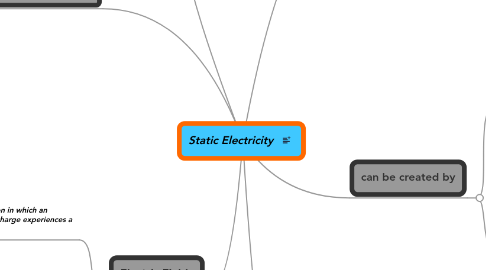
1. Consists of
1.1. Positive and Negative Charge
1.1.1. Unlike charges attract
1.1.2. Like charges repel
2. Examples of materials charged positive or negative
2.1. Positive
2.1.1. Glass (rubbed with silk)
2.1.2. Perspex (rubbed with wool)
2.2. Negative
2.2.1. Amber (rubbed with fur)
2.2.2. Rubber (rubbed with fur)
2.2.3. Polythene (rubbed with wool)
3. Electric Fields
3.1. the region in which an electric charge experiences a force
3.1.1. Field Lines
3.1.1.1. It is the path a a positive charge would take if it was free to move.
3.2. Electric field between parallel plates
3.2.1. The electric field between the parallel plates is central region.
3.2.1.1. Electric fields are closer to each other in a stronger electric field
4. can be created by
4.1. Charging by rubbing
4.1.1. Amber Rod + Fur
4.2. Charging by Induction
4.2.1. Van De Graff Generator
4.2.2. It is the production of electric charge on the surface of the conductor under the influence of an electric field.
5. Applied in
5.1. Photocopiers
5.2. Laser printers
5.3. Spraypainting
5.3.1. the car's body is earthed when it is being spray-painted, causing the paint to be attracted to the metal body. The droplets contain the same charge causing them to be evenly spread out
5.4. Electrostatic Precipitator
5.4.1. Removes dust particles by earthing the plates within the chimney, while keeping negatively-charged rods in between the metal plates. The air is ionised causing the dust particles to be attracted to the plates.
